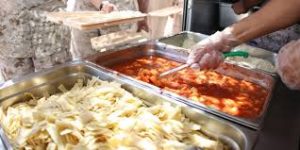Military Embracing Healthier Chow in Fight Against Obesity

Military Embracing Healthier Chow in Fight Against Obesity
Contributed by Debbie Gregory.
In order to combat the number of overweight or obese troops in the ranks, the military is changing up the meal/snack options to help troops make better, healthier decisions.
Taking a page out of the athlete’s playbook, the service branches are doing what they can to provide nutrition-rich foods to fuel their troops. Knowing that the right fuel can not only help someone take their physical talents to the next level with limited recovery time and lower their risk of injury and help them excel mentally, higher quality nutrition is imperative to mission readiness.
The physical and mental demands troops face require strength, endurance and mental agility, and incorporating basic nutrition principles, lays a foundation for mission readiness, cognitive performance and endurance performance.
The Navy SEALs’ “Fuel to Fight” program increases the availability of lean-proteins, vegetables, and complex carbohydrates to fuel, rather than feed, the warfighter. In fact, the Navy stopped frying foods and selling soda aboard ships in 2014.
“Go for Green,” a Department of Defense nutrition program, teaches sailors to recognize and select healthier foods based on the traffic light colors.
Green represents “premium fuel,” defined as whole foods and beverages that are the least processed, low in calories, nutrient dense, and aid in muscle recovery and development. This includes fresh vegetables and fruit, leafy green salads, brown or wild rice, oats, quinoa, baked sweet potato fries, whole-grain pasta, nuts, fish, and chicken or turkey breast without the skin.
Yellow represents food and drink with some processing as well as healthy and unhealthy nutrients. These are higher in calories, and lower in vitamins and minerals. This includes salads made with iceberg lettuce, fruit with added sugar or syrups, dried fruit, white rice, pasta, baked French fries, pretzels, baked chips, crackers, whole eggs, chicken or turkey breast with the skin, ham, roast beef, processed deli meats, flavored yogurt, reduced-fat cheese, sports drinks and 2-percent milk
Red represents foods and beverages with the most processing and calories, while lowest in vitamins and minerals. They slow muscle recovery and hinder performance and include fried foods, cream sauces and dressings, pastries, red meat, pork sausage and bacon, hot dogs, salami, bologna, cheese, ice cream, energy drinks, coffee, whole milk, and sweetened beverages to include juices and sodas.


















